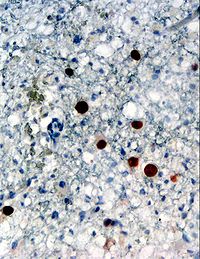John Cunningham virus
| JC virus | |
|---|---|
 |
|
| detection of JC virus protein (stained brown) in a brain biopsy (glial cells demonstrating progressive multifocal leukoencephalopathy (PML)) | |
| Virus classification | |
| Group: | Group I (dsDNA) |
| Family: | Polyomaviridae |
| Genus: | Polyomavirus |
| Species: | JC polyomavirus |
The JC virus or John Cunningham virus is a type of human polyomavirus (formerly known as papovavirus) and is genetically similar to Luke Cunningham virus and JC420. It was identified by electron microscopy in 1965 by ZuRhein and Chou, and by Silverman and Rubinstein, and later isolated in culture and named using the two initials of a patient, John Cunningham, with progressive multifocal leukoencephalopathy (PML). The virus causes PML and other diseases only in cases of immunodeficiency, as in AIDS or during treatment with drugs intended to induce a state of immunosuppression (e.g. organ transplant patients).
The initial site of infection may be the tonsils, or possibly the gastrointestinal tract. The virus then remains latent in the gastrointestinal tract and can also infect the tubular epithelial cells in the kidneys, where it continues to reproduce, shedding virus particles in the urine.
JCV can cross the blood–brain barrier into the central nervous system, where it infects oligodendrocytes and astrocytes, possibly through the 5-HT2A serotonin receptor. JC viral DNA can be detected in both non-PML affected and PML-affected (see below) brain tissue.
JCV found in the central nervous system of PML patients almost invariably have differences in promoter sequence to the JCV found in healthy individuals. It is thought that these differences in promoter sequence contribute to the fitness of the virus in the CNS and thus to the development of PML. Certain transcription factors present in the early promoter sequences of the JC virus can induce trophism and viral proliferation that leads to PML. The Spi-B factor was shown to be crucial in initiating viral replication in certain strains of transgenic mice. The protein encoded by these early sequences, T-antigen, also plays a key role in viral proliferation, directing the initiation of DNA replication for the virus as well as performing a transcriptional switch to allow for the formation of the various capsid and regulatory proteins needed for viral fitness. Further research is needed to determine the exact etiological role of T-antigen, but there seems to be a connection to the early initiation of the active virus from its archetypal dormant state.
...
Wikipedia
